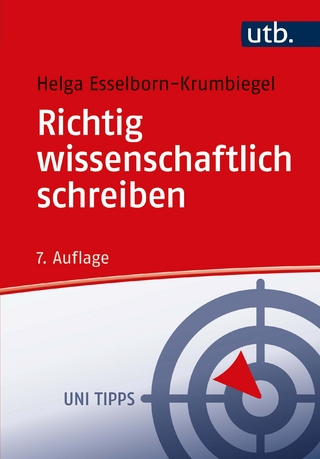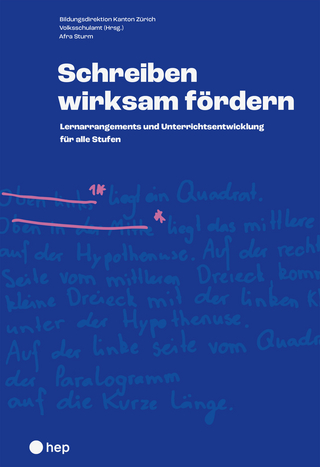
Teaching Reading to English Language Learners
Pearson (Verlag)
978-0-205-49217-6 (ISBN)
- Titel erscheint in neuer Auflage
- Artikel merken
Della Perez and Kathy Escamilla stress that meaning and relevance must be at the basis for all instructional activities and strategies in order to effectively develop oral and written language. In their newest book, the authors blend theory and practice that provides grade level and ESL teachers with the tools they need to differentiate literacy instruction for all students.
Dr. Herrera serves as a professor of Elementary Education at Kansas State University and directs the Center for Intercultural and Multilingual Advocacy (CIMA) in the College of Education and her research focuses on literacy opportunities with culturally and linguistically diverse students, reading strategies, and teacher preparation for diversity in the classroom. Dr. Herrera has recently published two books with Allyn and Bacon, Mastering ESL and Bilingual Methods: Differentiated Instruction for Culturally and Linguistically Diverse Students (2005) and Assessment Accommodations for Classroom Teachers of Culturally and Linguistically Diverse Students (2007). Dr. Herrera has also authored articles for numerous nationally known journals such as the Bilingual Research Journal, Journal of Hispanic Higher Education, Journal of Research in Education, and the Journal of Latinos and Education. Dr. Perez serves as an assistant professor of Elementary Education at Kansas State University and is the Associate Director of Undergraduate Programming at the Center for Intercultural and Multilingual Advocacy (CIMA) in the College of Education and her research has focused on literacy development and instruction for culturally and linguistically diverse students and parental involvement. Dr. Perez has published The Five Components of Reading Development: A Classroom Teacher’s Guide to Scaffolding Reading Instruction for ELL Students (2006) and ELL Literacy Interventions: Accommodations and Acceleration for Reading Success (2005). Dr. Herrera has also co-authored a book chapter for Culturally responsive teacher education: Language, curriculum, and community (2008). Kathy Escamilla is a Professor of Education at the University of Colorado, Boulder. She has been a bilingual teacher, program administrator and professor for over 37 years. She helped to develop the Spanish reconstruction of Reading Recovery (Descubriendo La Lectura) which was published in the book “”Instrumento de observación de los logros de la leco-escritura inicial.” (Heinemann). She has done extensive research in the area of literacy for Spanish speaking children in the U.S. and has authored over 40 journal articles in this area. She served two terms as the President of the National Association for Bilingual Education (NABE) and works as a technical assistant and consultant for Bilingual/ESL programs nationwide.
TABLE OF CONTENTS
Preface ............................................................................................................................. vi
Chapter 1
Language, Literacy, And The CLD Students ..................................... 1
Interactive Literacy: Defining Literacy For CLD Students ............................................. 6
Literacy Is Biographical ........................................................................................ 7
Literacy Is Fundamental ........................................................................................ 9
Literacy Is Research-Based .................................................................................. 10
Essential Elements Of Literacy Development ............................................................... 10
The Theoretical Foundations of Reading ...................................................................... 13
Reading the Symbols and Sounds of English: The Bottom-Up Reading Process
Model .................................................................................................................. 13
Literacy Instruction via the Bottom-Up Reading Process Model ....................... 14
Schematic Connections to Text: The Top-Down Reading Process Model .............. 16
Literacy Instruction via the Top-Down Reading Process Model........................ 17
Reading As a Circular Process: The Interactive Reading Process Model ................ 18
Literacy Instruction via the Interactive Reading Process Model......................... 19
Conclusion.................................................................................................................. 20
Chapter 2
Contextualizing Literacy Development For The CLD Student In The
Grade-Level Classroom ..................................................................... 27
The CLD Student Biography ....................................................................................... 29
The Sociocultural Dimension ................................................................................. 31
Historical Background Of The Family .............................................................. 32
Literacy Resources ......................................................................................... 34
Perceptions .................................................................................................... 36
The Language Dimension ...................................................................................... 38
Transfer Theory .............................................................................................. 38
Stages Of Second Language Acquisition And CLD Student Literacy
Development .................................................................................................. 39
The Academic Dimension ..................................................................................... 40
Prior Schooling ............................................................................................... 41
Academic Policy ............................................................................................. 43
The Cognitive Dimension ...................................................................................... 44
Cognition, Language, And Literacy Development ............................................ 45
Culturally Relevant Texts: Making The Sociocultural Connection....................... 46
Conclusion ................................................................................................................. 47
Chapter 3
Rethinking Phonemic Awareness: A Cross-Linguistic Transfer
Perspective .......................................................................................... 58
Phonological Awareness And Cross-Language Transfer .............................................. 61
Phonemic Awareness And Cross-Language Transfer ................................................... 63
Contextualizing Phonemic Awareness Instruction ......................................................... 67
Phonemic Awareness Tasks: Identifying The Subtleties Of The English
Language .............................................................................................................. 68
Phoneme Isolation .......................................................................................... 69
Phoneme Identity ............................................................................................ 72
Phoneme Categorization ................................................................................. 73
Phoneme Blending .......................................................................................... 75
Phonemic Segmentation .................................................................................. 77
Phoneme Deletion ........................................................................................... 79
Phoneme Addition .......................................................................................... 80
Phoneme Substitution ...................................................................................... 81
Instructional Guidelines for Phonemic Awareness ................................................... 82
Conclusion ................................................................................................................. 83
Chapter 4
Phonics: More Than The A, B, Cs of Reading .................................. 99
What Comes First: The Letters Or The Words ............................................................ 102
Phonics And Cross-Language Transfer ....................................................................... 103
Contextualizing Phonics Instruction............................................................................... 107
Writing Your Own Script: Creating An Integrated Approach To Phonics
Instruction .................................................................................................................. 111
Principle 1: Phonics Knowledge Is Developmental ................................................. 113
Principle 2: Phonics Instruction Is Integrated Into Beginning Reading And
Writing Instruction ............................................................................................. 113
Principle 3: Phonics Knowledge Is Important Not For Itself But In Its
Application ........................................................................................................ 114
Principle 4: Strategic Knowledge Is Required To Use Phonics Concepts
And Skills .......................................................................................................... 114
Principle 5: Phonics Instruction Involves Teacher Decision-Making......................... 114
Principle 6: Peers Teach Each Other Phonics As They Read And Write
Side-By-Side .................................................................................................... 115
Integrated Phonics In A Second-Grade Classroom ................................................ 115
Integrated Phonics In A Fourth-Grade Classroom ................................................. 117
Conclusion ................................................................................................................. 119
Chapter 5
Vocabulary Development: A Framework For Differentiated And
Explicit Instruction ............................................................................. 149
Implications Of Approaches To Vocabulary Development ........................................... 153
Current Approaches To Vocabulary Instruction ..................................................... 153
Reader-Based Instruction ............................................................................... 154
Interactive Language Learning ......................................................................... 155
Direct Instruction ............................................................................................ 156
Teaching Vocabulary Within A Linguistic And Cultural Context ............................. 157
The Cultural Biography Of The CLD Student: From The Known To The Unknown 158
Sociocultural Dimension ............................................................................ 160
Linguistic Dimension ................................................................................. 161
Preproduction ..................................................................................... 162
Early Production ................................................................................. 162
Speech Emergence ............................................................................. 163
Intermediate Fluency ........................................................................... 163
Advanced Fluency .............................................................................. 164
Academic Dimension ................................................................................ 165
Bridging And Connecting Through Cognates ....................................... 166
Cognitive Dimension ................................................................................. 167
Situating Instruction Based On The CLD Student Biography ................ 168
Vocabulary Selection .................................................................... 169
Before-The-Lesson Strategies: Tapping Into Prior And
Background Knowledge To Bridge And Connect ....................... 171
Practicing And Applying Academic Vocabulary ............................. 174
Creating Interactive Learning Environments ................................... 176
Assessing CLD Students’ Acquisition Of English Academic
Vocabulary ................................................................................ 178
Conclusion ........................................................................................................... 179
Chapter 6
Strategies-Based Comprehension Instruction: Linking The Known To
The Unknown...................................................................................... 195
Comprehension: Constructing Meaning From Text........................................................ 199
Building From The Known To The Unknown ........................................................ 200
Schematic Connections In Practice .................................................................. 201
Putting Reading Comprehension Strategies Into Practice ........................................ 203
Metacognitive Strategies — “Thinking About Our Thinking” .............................. 204
In My Head .............................................................................................. 206
True Or False? ......................................................................................... 206
Sticking To The Main Idea ........................................................................ 207
Question Bookmark ................................................................................. 208
Cognitive Strategies To Promote Reading Comprehension ............................... 208
SEA Box .................................................................................................. 209
Visualize-Interact-Predict (VIP) ................................................................ 209
1, 2, 3 Imagery ......................................................................................... 212
Signature Lines ......................................................................................... 212
Story Retelling .......................................................................................... 213
Social/Affective Comprehension Strategies ...................................................... 215
Critical Questions ..................................................................................... 215
Through My Eyes ..................................................................................... 216
Conclusion ................................................................................................................. 217
Chapter 7
Fluency In Practice: More Than “Reading” The Text ...................... 247
Deep Constructs Of Fluency Development .................................................................. 250
The Multiple Dimensions Of Phonemic Awareness And Phonics ............................ 250
Decoding Through Cross-Language Transfer ................................................... 250
Articulation Of Orthographic Cues .................................................................. 252
Prosidic Elements Of The English Language In Practice ................................... 254
Stressing The Important Sounds In Words ................................................ 254
High Tones And Low Tones Of The English Language .............................. 255
Phrasing And Reading Fluency .................................................................. 256
The Role Of Vocabulary Knowledge .................................................................... 257
Automaticity Through Repeated Reading ......................................................... 258
Comprehension As The Key.................................................................................. 261
Learning Strategies In Practice ........................................................................ 262
Supporting Fluency Development Through Collaboration ............................................. 263
Acting On Fluency: Readers’ Theater For CLD Students ....................................... 264
Choral Reading ..................................................................................................... 266
Repeated Reading ................................................................................................ 268
Sustained Partner Reading .................................................................................... 269
Conclusion.................................................................................................................. 270
Chapter 8
Implications Of Culture And Language In Writing ........................... 283
Differences Between Oral And Written Language Development ................................... 288
Teaching Writing In A Second Language ..................................................................... 289
Discourse Patterns ................................................................................................ 293
Interactive + Direct Approaches To Teaching Writing To CLD Students ................ 294
Getting Started: Beginning Writing ................................................................... 295
Interactive Spelling For CLD Students: From Individual To Cooperative
Team ........................................................................................................... 299
Assessing The Writing Of Second Language Learners: Looking For
Strengths......................................................................................................... 301
Conclusion ................................................................................................................. 305
Chapter 9
Outside The Lines: Assessment Beyond The Politics Of
High Stakes Tests................................................................................ 324
Overtested Without A Foundation ............................................................................... 327
Authentic Assessment Defined .................................................................................... 328
Authentic Reading Assessment (ARA) Within A CLD Context .................................... 329
Socioculturally Speaking ....................................................................................... 330
Language As A Cultural Response ........................................................................ 330
Academic Considerations ..................................................................................... 332
Cognitive Pathways .............................................................................................. 332
Point Of Departure: Preinstructional ARA ................................................................... 333
Thinking, Learning, And Formative Assessment ........................................................... 334
Feedback In Formative Assessment ...................................................................... 334
Questions As Tools In Reading Assessment .......................................................... 336
Putting The Pieces Together: Student Case Studies ...................................................... 338
Yamin: Where Am I? ............................................................................................ 338
So Yeong: Between Two Worlds .......................................................................... 342
Conclusion ................................................................................................................. 347
Chapter 10
Inclusive Literacy Instruction for CLD Students ............................... 361
Setting The Goal: Standards-Driven Literacy Instruction ............................................. 365
The Standards For English Language Arts ............................................................. 365
ESL Standards For Pre-K — 12 ............................................................................ 369
Fidelity And The CLD Learner ................................................................................... 371
Embedding Strategies In Your Existing Curriculum ................................................. 372
Standards — Reading Programs — CLD Student Biography .......................................... 373
Sociocultural Knowledge ...................................................................................... 373
Linguistic Knowledge ............................................................................................ 374
Academic Knowledge .......................................................................................... 375
Cognitive Knowledge ........................................................................................... 376
Conclusion ................................................................................................................. 377
Glossary ..................................................................................................................... 382
References.................................................................................................................. 387
| Erscheint lt. Verlag | 13.2.2009 |
|---|---|
| Sprache | englisch |
| Maße | 191 x 232 mm |
| Gewicht | 544 g |
| Themenwelt | Schulbuch / Wörterbuch |
| Sozialwissenschaften ► Pädagogik | |
| ISBN-10 | 0-205-49217-7 / 0205492177 |
| ISBN-13 | 978-0-205-49217-6 / 9780205492176 |
| Zustand | Neuware |
| Haben Sie eine Frage zum Produkt? |
aus dem Bereich



